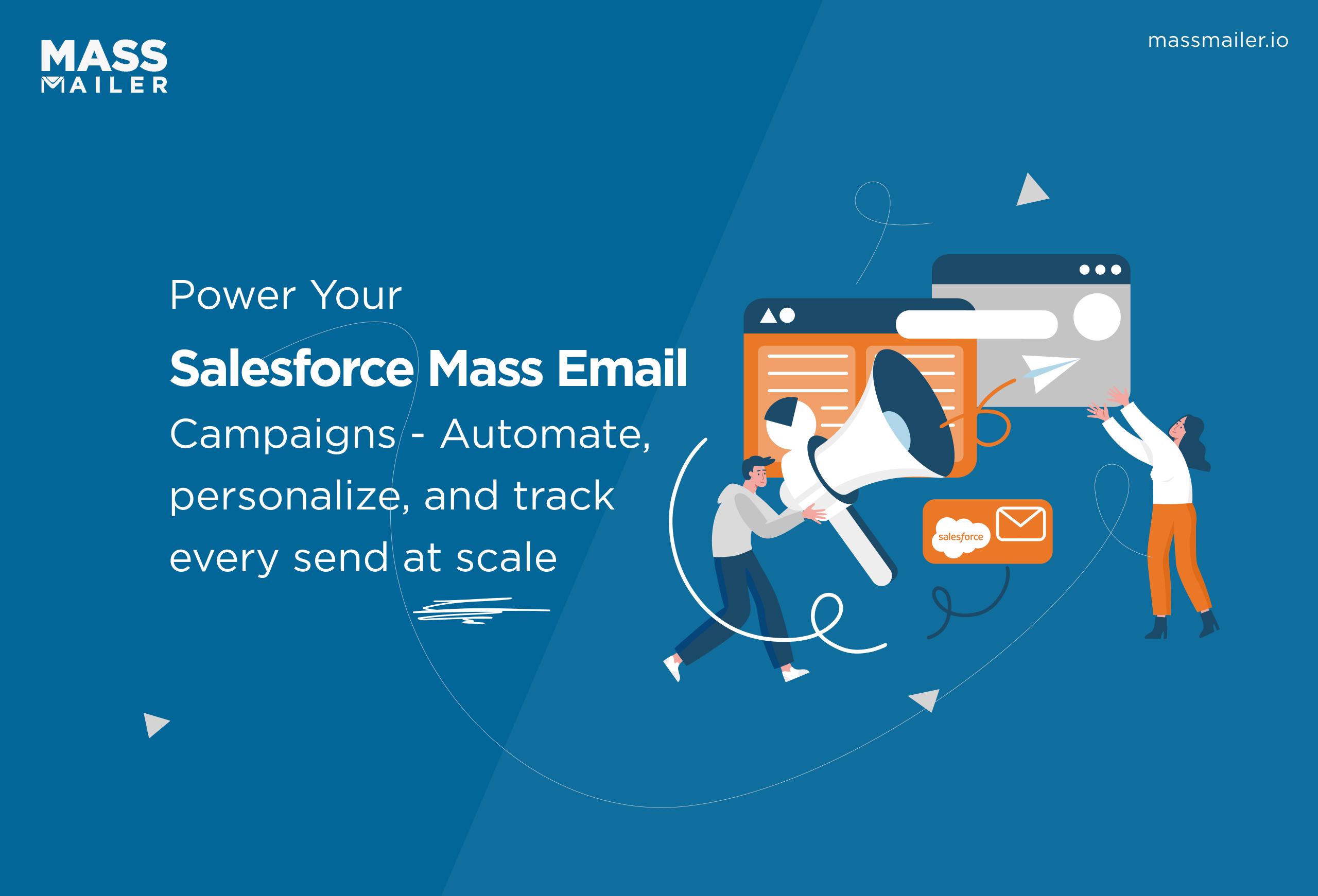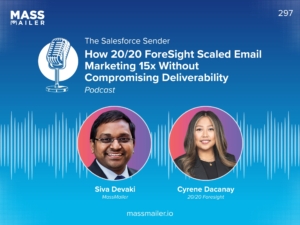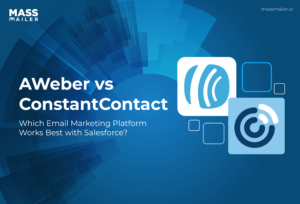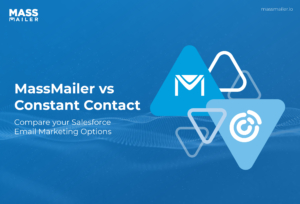Table of Contents
Introduction
You’ve likely heard the buzz: “Email marketing is dead.” According to Gartner’s research, 44% of Chief Marketing Officers (CMOs) consider email marketing essential to their overall digital strategy, allocating nearly 8% of their digital marketing budget to the channel.
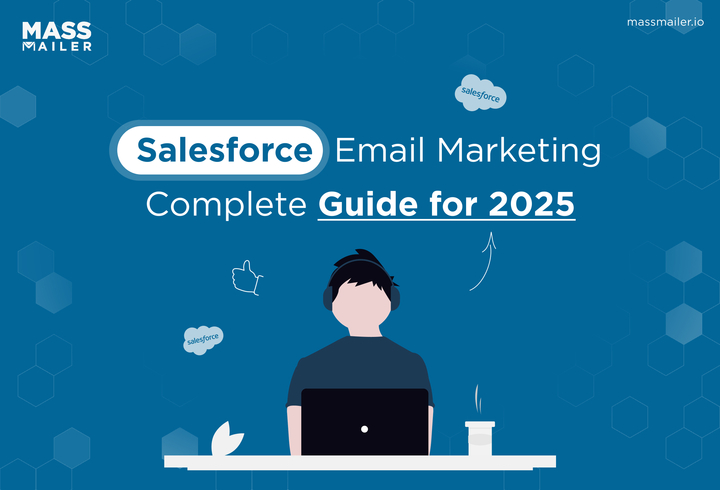
Yet, despite its critical role, many businesses struggle with the complexity of executing effective email campaigns. If you’ve ever felt overwhelmed by the sheer number of tools, features, and customization options that Marketing tools like Salesforce offer, you’re not alone.
You’re constantly asking yourself: Is this really worth the time and effort, or am I just drowning in features I’ll never use?
The reality is, Salesforce email marketing can be a game-changer if you get it right. It’s designed to help businesses scale their campaigns, increase personalization, and boost ROI.
But, like any powerful tool, it requires a solid understanding of its full potential. Whether you’re new to Salesforce or looking to optimize your existing setup, this guide will show you how to unlock the platform’s full capabilities, simplify the process, and avoid the common pitfalls that many marketers face.
Let’s break down how you can get the most out of Salesforce email marketing without feeling lost in the complexity. From audience segmentation and dynamic personalization to advanced automation and AI-driven insights, Salesforce has the tools to make email marketing not just effective but also easier.
What is Salesforce email marketing?
Salesforce email marketing refers to the use of Salesforce’s Marketing Cloud, Pardot (now called Account Engagement), or Salesforce CRM tools to design, send, and optimize email campaigns. Unlike standalone email platforms, Salesforce integrates seamlessly with CRM data, making it possible to connect every email with a customer’s journey.
These tools empower marketers to deliver relevant emails at scale, improve deliverability, and track detailed metrics for measurable ROI. By leveraging automation and AI-driven insights, Salesforce helps businesses create impactful email campaigns that nurture leads, boost customer loyalty, and drive sales.
Key features
Here’s a breakdown of the key capabilities of Salesforce email marketing:
Audience segmentation
One of the strongest features of Salesforce email marketing is its audience segmentation capabilities. Marketers can segment their contact lists based on a variety of criteria pulled directly from the CRM, including demographic details (age, job title, location), behaviors (purchase history, website visits), and engagement data (email opens, clicks).
This allows for highly targeted and personalized email campaigns that reach the right people with the right content at the right time.
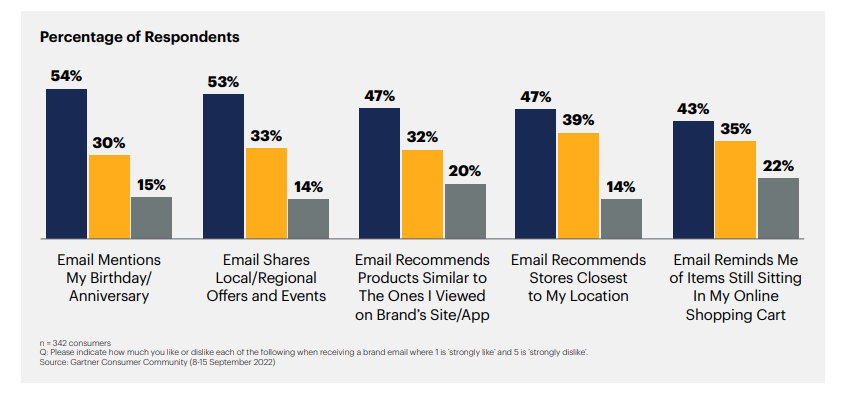
Dynamic personalization
Salesforce offers dynamic personalization at a level unmatched by many standalone email platforms. By using CRM data, Salesforce allows marketers to personalize every aspect of an email, from greeting lines to product recommendations, based on customer behavior. This goes beyond just using the recipient’s name in the subject line.
Automation
Automation is a critical feature in Salesforce email marketing, particularly through tools like Salesforce Flows and Engagement Studio. These tools allow marketers to set up behavior-triggered workflows and automated customer journeys based on real-time interactions, ensuring that customers receive timely and relevant communications.
These automations are especially valuable for marketers who need to scale their email efforts without sacrificing personalization or relevance. Salesforce’s ability to automate these processes ensures businesses can keep their customer engagement high while freeing up time for strategic planning.
Testing & analytics
Salesforce provides built-in tools for A/B testing, allowing marketers to experiment with different subject lines, copy, layouts, and calls-to-action (CTAs). These tests help businesses determine which variations perform best and optimize campaigns in real-time.
Salesforce’s visual dashboards also provide detailed performance analytics, including metrics like open rates, CTR, conversion rates, and bounce rates. This rich data set enables businesses to continuously improve their campaigns, refine audience segments, and ultimately increase revenue.
By integrating deeply with CRM data, Salesforce enables marketers to deliver content that is not only relevant but also timely, while ensuring compliance and maintaining high deliverability rates. These features make Salesforce an ideal solution for businesses looking to optimize their email marketing efforts and scale their campaigns efficiently.
Limitations of Salesforce email marketing
Salesforce email marketing provides a robust suite of features, but like any enterprise platform, it comes with challenges that organizations need to evaluate before committing resources. Understanding these limitations helps businesses make informed decisions and avoid common pitfalls.
Licensing and costs
One of the most cited concerns is cost. Salesforce Marketing Cloud and Pardot (Account Engagement) are priced for mid to large enterprises, which can make them less accessible for startups or smaller teams.
Beyond licensing, costs can increase with add-ons, advanced analytics, or integrations with third-party platforms.
In fact, many users often express similar frustrations when they first encounter Salesforce pricing. One user, for example, struggled to understand what the $25 per user per month actually covers. They wondered if they would need to pay extra for a second admin or for community users, reflecting a common confusion about how Salesforce structures its licenses.
Other commenters explained that the $25 option is very limited and most businesses quickly realize they need to upgrade, often ending up paying $75 to $100 per user per month for a package that truly supports their operations.
This conversation highlights a reality that startups and smaller teams frequently encounter: Salesforce can feel expensive upfront, but the cost is tied to the depth of features, user roles, and the potential ROI from using a fully configured platform.
It reinforces why careful planning around the number of users, types of licenses, and necessary add-ons is critical to avoid unexpected expenses while maximizing the platform’s value.
This often means businesses must assess whether they have the volume, complexity, or growth trajectory to justify the investment. Organizations that underestimate the total cost of ownership risk overspending on features they may not fully use.
Steep learning curve
The flexibility of Salesforce email marketing is a double-edged sword. With advanced tools like dynamic personalization and automation flows, the platform can take significant time to master. Teams often require formal training or certification to use Salesforce effectively.
For example, one user, sharing their experience with Salesforce, highlighted that while the platform is powerful, it can feel overwhelming for both new users and those trying to scale it effectively.
They noted that every new feature or tool comes with its own complex setup and administrative requirements, creating what they called an “admin rabbit hole.” This complexity is not uncommon, as Salesforce users often find themselves needing to rely heavily on internal or external Salesforce experts to make the most out of the platform’s capabilities.
For businesses that lack a dedicated Salesforce team, this can become a major bottleneck.
This feedback aligns with the concerns many face when adopting Salesforce email marketing. Its full potential can only be unlocked through a deep understanding of its tools. Without adequate onboarding, users can end up only scratching the surface, missing out on features like advanced automation and dynamic personalization that could significantly boost campaign ROI.
The technical complexity involved in customizing and fine-tuning Salesforce often leads to longer onboarding periods and can slow down campaign execution in the early stages, making it crucial for businesses to plan for proper training and support when implementing the platform.
Reliance on CRM data quality
Salesforce email campaigns are only as effective as the data feeding them. If customer records are outdated, incomplete, or inconsistent, segmentation and personalization suffer. For example, sending duplicate emails because of improperly merged records erodes customer trust.
The challenge is more widespread than many organizations realize. According to Gartner surveys, 59% of organizations do not measure data quality, making it difficult for businesses to fully understand the impact of poor data on their campaigns.
Without consistent data quality measurement, businesses are left flying blind, unable to address critical gaps in their customer information, which directly affects the success of their email marketing efforts.
Inaccurate data can also lead to irrelevant content, reducing engagement and increasing unsubscribe rates. Businesses need clear data governance processes, such as regular deduplication and validation, to unlock the full potential of Salesforce email marketing.
Technical complexity for customization
While Salesforce provides user-friendly drag-and-drop tools, advanced customization often requires technical skills. Personalization using AMPscript or API-driven campaigns allows for powerful automation but typically demands developers or specialists.
This can create dependencies on technical teams and extend campaign lead times. For organizations without in-house expertise, external consultants or agencies may be required, adding further costs.
Email sending limitations
Salesforce enforces daily and hourly email send limits to maintain platform stability and protect sender reputation. While these thresholds are designed to encourage responsible sending, they can pose challenges for organizations managing very large databases or frequent campaigns.
Businesses running global operations may find that limits complicate scheduling across time zones. Planning campaigns with staggered sends or prioritizing key segments becomes essential to work within these constraints.
These limitations do not negate the advantages of Salesforce email marketing, but they highlight the importance of planning..
Step-by-step guide to create a Salesforce email marketing campaign
Below is a detailed breakdown of how to set up an email campaign using Salesforce.
Step 1: Set up data sources
The foundation of any Salesforce email campaign is the quality of your data. It means importing or syncing leads, contacts, and account information from your CRM into Marketing Cloud or Pardot.
Poor data hygiene is one of the biggest reasons campaigns underperform. Duplicate records, outdated email addresses, or incomplete fields can lead to wasted sends and reduced deliverability.
Before launching, marketers should use Salesforce’s data management tools to deduplicate contacts, validate email addresses, and ensure segmentation fields such as industry, region, or purchase history are complete. A campaign built on inaccurate data risks damaging both engagement and sender reputation.
Step 2: Choose your tool
Salesforce offers different tools for different needs, and choosing the right one is critical. Marketing Cloud Email Studio is typically used by B2C marketers who need high-volume sends and advanced automation.
Pardot (Account Engagement) is geared toward B2B companies focusing on lead nurturing and scoring, where sales alignment is crucial. Smaller businesses may start with Salesforce Starter, which offers simplified email capabilities integrated into the CRM. Selecting the right tool ensures marketers are not overpaying for functionality they don’t use or missing out on features that could significantly improve results.
Step 3: Design your email
Salesforce provides multiple options for building email templates, including drag-and-drop editors, customizable layouts, and HTML or AMPscript for advanced users. The design process should always prioritize clarity and mobile responsiveness.
Marketers should avoid image-heavy layouts that load slowly, and instead focus on concise copy, prominent calls-to-action, and accessible design. Consistent branding across headers, colors, and typography reinforces recognition and trust with recipients.
Step 4: Segment your audience
One of Salesforce’s biggest strengths lies in its CRM-driven segmentation. Rather than sending a blanket message to all contacts, marketers can use filters like job title, deal stage, purchase frequency, or support history to send highly relevant content.
For example, a SaaS company could differentiate between trial users and enterprise customers, offering product tutorials to the first group and advanced feature updates to the second. Segmentation ensures campaigns are contextually relevant, improving engagement and reducing unsubscribe rates.
Step 5: Add personalization
Personalization in Salesforce goes far beyond inserting a first name in the greeting. With access to detailed CRM data, marketers can dynamically insert product recommendations, event reminders, or account-specific offers into their emails.
Salesforce Einstein AI further enhances this process by predicting the type of content most likely to resonate with each recipient. For instance, Einstein can suggest the best send times for individual subscribers or identify subject lines that are likely to drive higher opens. Effective personalization not only boosts engagement but also reinforces that the brand understands each customer’s unique context.
Step 6: Test and preview
No campaign should go live without testing. Salesforce makes it possible to run A/B tests on subject lines, calls-to-action, or design variations to understand what resonates most with your audience.
Marketers should also preview emails across different devices and email clients, since rendering can vary significantly between desktop and mobile or between providers like Gmail and Outlook.
Deliverability testing is equally important. Using spam filter previews helps avoid common pitfalls that cause campaigns to be flagged or filtered before reaching the inbox. Thorough testing ensures the campaign performs as intended when it lands in front of real customers.
Step 7: Send or automate
Marketers can choose between sending one-off campaigns or embedding emails into automated customer journeys. For time-sensitive announcements or promotions, a scheduled blast may suffice. For long-term engagement, Journey Builder or Pardot Engagement Studio allows for complex, behavior-driven sequences.
A new subscriber might receive a welcome email immediately, followed by product education over several days, and eventually a promotional offer. Automating these workflows ensures timely, consistent engagement without requiring constant manual effort.
Step 8: Track performance
The final step is to measure the effectiveness of the campaign. Salesforce provides detailed dashboards that show metrics such as open rates, click-through rates, and conversions. More importantly, because campaigns are tied directly to CRM data, marketers can track revenue attribution, understanding not just who clicked, but which interactions led to actual sales.
This level of reporting allows teams to optimize future campaigns with evidence rather than assumptions.
Salesforce email marketing best practices
To get consistent results, marketers need to apply proven practices that improve deliverability, engagement, and compliance.
Craft subject lines that drive opens
The subject line is often the deciding factor for whether an email is opened or ignored. In Salesforce email marketing, subject lines should be concise, relevant, and aligned with the customer’s stage in the journey.
Long or generic lines tend to get cut off, particularly on mobile devices. Marketers can use Salesforce’s A/B testing functionality to evaluate multiple variations and identify which tone or phrasing resonates best with their audience.
Personalize campaigns using CRM data
Salesforce’s biggest strength is its ability to tie campaigns to CRM data. Personalization should extend beyond using the recipient’s first name. Marketers can pull in purchase history, service interactions, or regional preferences to create more relevant emails.
For example, a travel company can promote flight deals from the recipient’s nearest airport, while a SaaS provider can send tailored feature updates based on the user’s subscription plan.
Leveraging Einstein AI enhances personalization further by predicting which type of content or offers are most likely to drive engagement. This level of personalization not only improves results but also reduces unsubscribes caused by irrelevant messaging.
Segment audiences for higher relevance
Segmentation ensures the right message reaches the right people. Salesforce enables marketers to filter audiences based on demographic information, engagement history, or lifecycle stage. Instead of sending the same content to an entire database, campaigns can be customized for prospects, active customers, or dormant users.
A B2B company might build separate email flows for decision-makers and technical evaluators, ensuring both groups receive content that speaks to their priorities.
Maintain list hygiene and deliverability standards
Strong deliverability is essential for Salesforce email marketing success. Outdated or inactive contacts can lower sender reputation and push future campaigns into spam folders. Regular list hygiene practices, such as removing hard bounces, honoring unsubscribe requests, and revalidating email addresses, protect campaign performance.
Salesforce provides tools to manage suppression lists and track deliverability metrics, allowing marketers to identify problems early. Clean lists not only improve inbox placement but also give more accurate reporting on engagement. This ensures resources are focused on audiences who are most likely to respond.
Test and refine with A/B experiments
Even well-planned campaigns benefit from continuous improvement. Salesforce’s testing capabilities allow marketers to experiment with different subject lines, content layouts, images, or calls-to-action.
Instead of relying on assumptions, A/B testing provides evidence of what actually works for a particular audience. For example, a retailer may discover through testing that short, benefit-driven CTAs outperform longer, descriptive ones.
Over time, these insights compound, helping teams refine strategies and increase ROI. Testing also reduces the risk of missteps by allowing marketers to validate ideas on smaller segments before rolling them out more broadly.
Salesforce email marketing tools & integrations
Salesforce email marketing is most powerful when marketers understand how to use its ecosystem of tools in combination. Each tool solves a different challenge, from building campaigns to automating journeys, and when paired with integrations, the platform becomes a comprehensive marketing hub.
Email Studio
Email Studio is the backbone of Salesforce email marketing. It allows marketers to design, send, and track personalized campaigns at scale. What sets it apart from traditional email editors is its connection to CRM data.
Instead of relying on static lists, marketers can dynamically pull in customer details such as purchase history, preferences, or past interactions. This ensures that every email is highly relevant.
Email Studio also provides granular reporting so teams can measure campaign performance and refine their approach. For a retail brand, this could mean sending different versions of a seasonal campaign to first-time buyers versus repeat customers, based on data already stored in Salesforce.
Pardot (Account Engagement)
For B2B organizations, Pardot (recently rebranded as Account Engagement) provides email marketing capabilities tailored to lead generation and nurturing. Unlike Email Studio, which is built for high-volume B2C sends, Pardot emphasizes quality interactions that guide prospects through the sales funnel.
Features like lead scoring, grading, and integration with Salesforce CRM allow marketing and sales teams to align more closely. This means that when a prospect engages with a webinar invite or a product demo email, sales reps can see that interaction in real time and follow up with context. This alignment reduces the gap between marketing campaigns and revenue outcomes.
Einstein AI
Einstein AI brings predictive intelligence to Salesforce email marketing. It uses machine learning to analyze engagement patterns and recommend the best subject lines, send times, and content. For marketers, this removes guesswork and supports data-driven decision-making.
One of its most impactful applications is send-time optimization, where emails are automatically delivered when each subscriber is most likely to engage. Another is content prediction, which surfaces the products or articles most relevant to each recipient. This not only improves engagement rates but also reduces the risk of overwhelming audiences with irrelevant content.
Integrations
MassMailer is a powerful native integration that supercharges Salesforce email marketing by overcoming the platform’s sending limitations. With MassMailer, Salesforce users can send unlimited emails, whether they are transactional emails, marketing messages, or drip campaigns.
It enables users to bypass the daily sending caps imposed by Salesforce, allowing for large-scale email campaigns without disruption.
MassMailer also brings added value through its easy-to-use email wizard, which allows Salesforce users to build and send professional-looking emails without requiring HTML knowledge.
Marketers can also use MassMailer’s email template builder to create responsive email templates directly within Salesforce, streamlining the campaign design process.
Conclusion
We all know the frustration of running email campaigns that just don’t seem to get the results you expect. Even with a tool as powerful as Salesforce, it’s easy to feel like you’re swimming against the current, whether it’s the overwhelming number of features, the complexities of customization, or the constant pressure to keep CRM data in top shape.
Salesforce, when used correctly, is an extremely powerful platform for email marketing. What many businesses fail to realize is that the most successful Salesforce email campaigns come from a deep understanding of both the tool and the data behind it.
This requires time, effort, and sometimes external help. But once you conquer these challenges, Salesforce becomes a tool that can dramatically improve your ROI by fostering better customer relationships and more targeted campaigns.
If you’re ready to unlock the full potential of your Salesforce email campaigns without the complexity, MassMailer is here to help. Streamline your email marketing, bypass sending limitations, and enhance deliverability, all within the Salesforce platform.
Book a call with us today to learn how MassMailer can simplify your email marketing, improve performance, and drive better results!
Frequently Asked Questions
Can I use Salesforce for both B2B and B2C email marketing?
Yes. Salesforce offers dedicated tools for both contexts. Pardot (now called Account Engagement) is ideal for B2B lead nurturing and aligning with sales teams, while Marketing Cloud is designed for B2C brands running large-scale, personalized campaigns. Choosing the right tool depends on your customer base and campaign goals.
Is Salesforce email marketing suitable for small businesses?
It can be, though it’s often priced for mid-to-large enterprises. Smaller teams may find Salesforce Starter a more accessible option, offering simplified email capabilities integrated with CRM. However, costs may still be higher than lighter ESPs, so small businesses should evaluate ROI before adopting.
How do I measure ROI in Salesforce email marketing?
Salesforce provides built-in dashboards and reporting tools that go beyond opens and clicks. Marketers can track conversions, revenue attribution, and engagement tied directly to CRM data. This makes it possible to connect email campaigns with actual sales outcomes and long-term customer value.
Do I need coding skills to use Salesforce for email marketing?
Not necessarily. Salesforce’s drag-and-drop editors make it easy to design campaigns without technical skills. That said, advanced personalization and automation often rely on HTML or AMPscript, which may require developer support or specialist knowledge for full customization.
What’s the biggest advantage of Salesforce email marketing?
The biggest advantage is its deep CRM integration. Unlike standalone email platforms, Salesforce ties every campaign to customer records, enabling smarter segmentation, personalized journeys, and measurable revenue impact. This allows marketers to move beyond bulk sends and build data-driven, context-rich campaigns.
Start Your Free Trial Today
Experience MassMailer the easiest way to send personalized emails from Salesforce.
Related Blogs
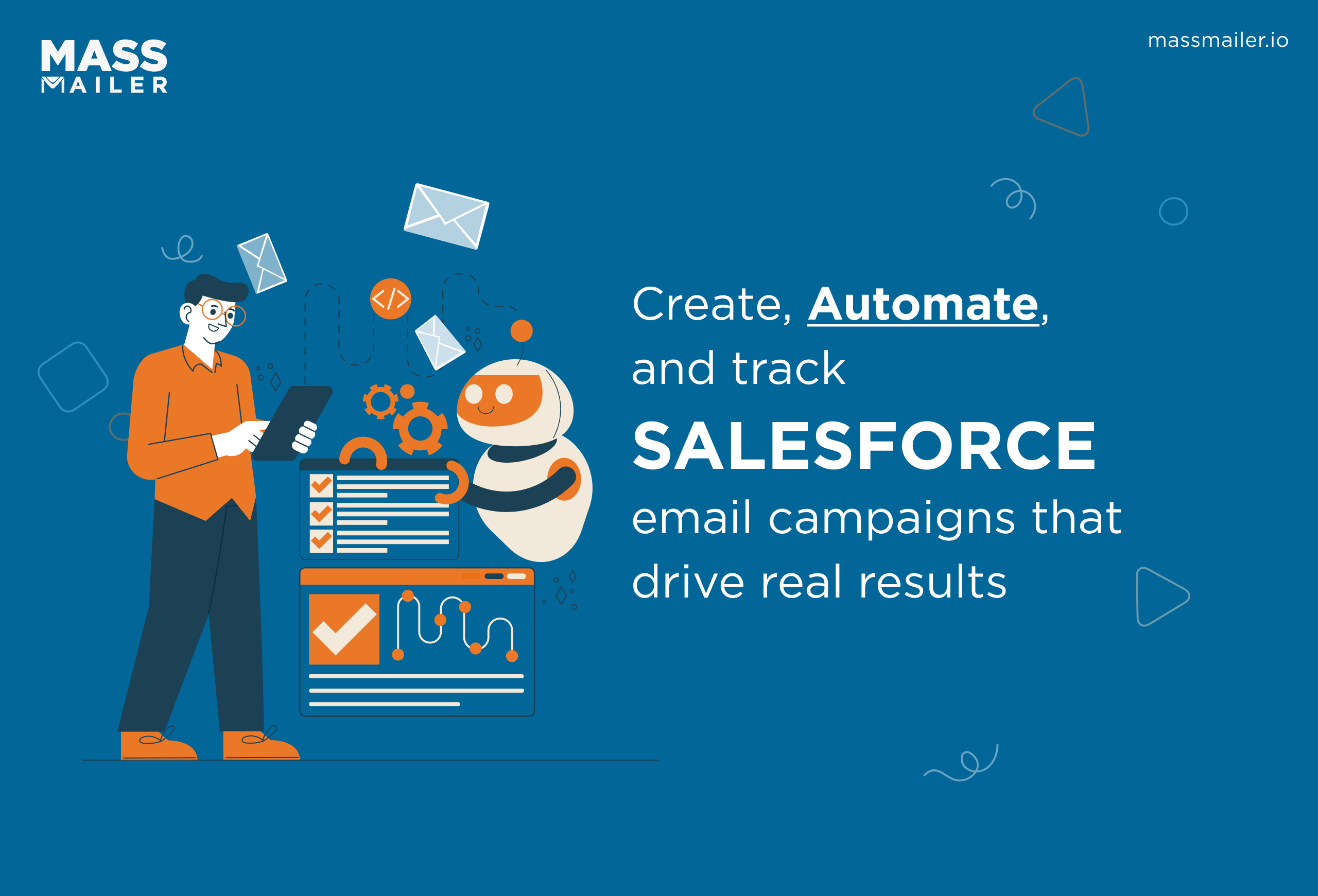
How to Create and Optimize Salesforce Email Campaigns with MassMailer
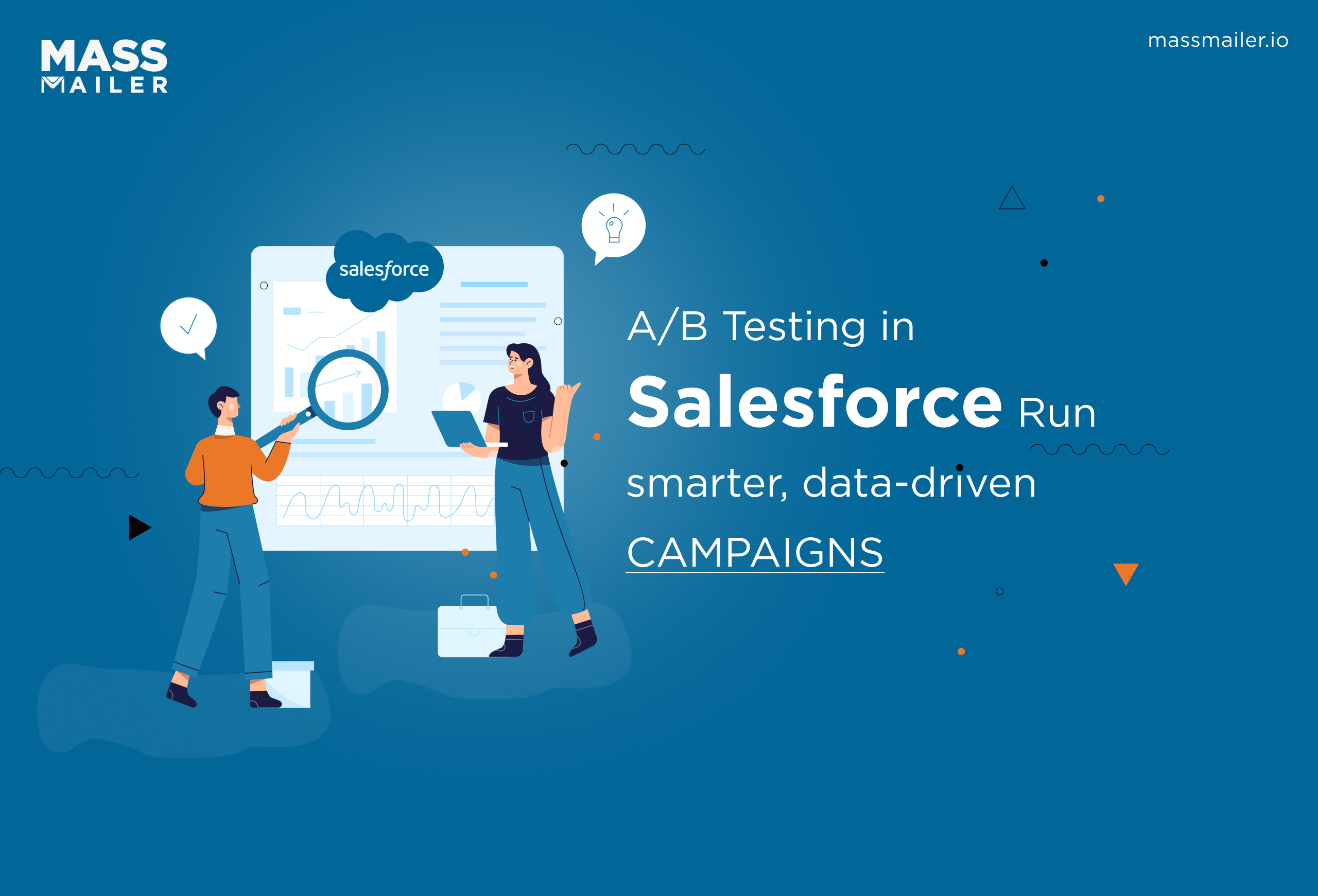
A/B testing Salesforce: Run data-driven campaigns that convert
MassMailer Resources


